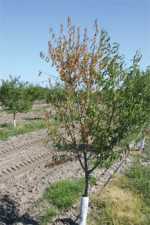Tackling Verticillium Wilt In Almonds

I visited an almond orchard last summer in Manteca, CA, with second-leaf trees showing Verticillium wilt. Cool, wet spring conditions favor Verticillium wilt on young almond trees, and we certainly had that this year in the San Joaquin Valley. Leaves on one or more branches, often on only one side of the tree, will turn yellow and wilt early in the growing season.
Affected young shoots typically resemble a shepherd’s hook. When shoot, branch, or trunk tissue of infected trees is cut, the vascular tissue and often much of the heartwood will display dark discoloration. Foliar symptoms usually appear only on young trees (first to fifth or sixth leaf). Older infected trees do not normally exhibit symptoms of Verticillium wilt, though yields may be reduced as a result.
Verticillium dahlia, the causal fungus, can survive many years as hardened spores called microsclerotia, either in soil, in the debris of previous susceptible crops, or in roots of infected trees. The soilborne fungus invades tree roots and then grows up the xylem, or water-conducting tissues. The fungus eventually plugs up the xylem and the shoots wilt because they are not getting enough water. Hot summer temperatures eventually cause the fungus to dieback in scaffolds, but it can continue to live on tree roots. Do not immediately cut out diseased branches, for they often grow back nicely with the summer heat. Wait until winter to prune when you can accurately assess the damage.
Fungus Among Us
Verticillium naturally occurs in low populations in the San Joaquin Valley, but years of farming susceptible crops (tomatoes, cotton, cucurbits, strawberries, etc.) have dramatically increased microsclerotia populations in our soils. When replanting in an area where susceptible perennials were previously grown, try to remove as many roots of the previous crop as possible, and have soil samples taken to determine inoculum levels. Soil samples should be taken from the top 12 inches, where populations will most likely range from 0 to 60 microsclerotia per gram. Wilt can occur with as little as 1 to 3 microsclerotia per gram and the ideal environmental conditions (cool, wet soil).
Pre-plant fumigation with chloropicrin or combinations of methyl bromide and Telone (1,3-Dichloropropene, Dow AgroSciences) have reduced Verticillium populations. Solarization with clear plastic is also effective pre-plant, while black plastic can be used post-plant. To solarize soil before planting, cover moistened soil with clear UV-inhibited plastic in late spring, and leave the plastic in place during the hot summer months. To solarize soil after tree planting, cover the soil around the trees with black plastic and leave in place for one to two growing seasons.
When it comes to choosing rootstocks, Mariana 2624 has been shown to be somewhat more resistant to Verticillium wilt than peach or peach/almond hybrid rootstocks. Avoid interplanting young orchards with susceptible cover plants, such as cotton and tomatoes.









